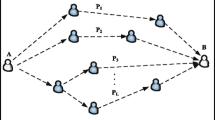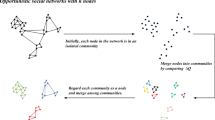Abstract
Information-assisted routing algorithms improve the performance of mobile opportunistic networks (MONs), where node utility and packet redundancy are used in the data forwarding process. Making a tradeoff between the forwarding performance and network overhead is the key problem in MONs. In this study, we propose a multiple-copy routing scheme based on node relationship mining. This scheme considers the influence of the difference and dynamic variability of the relationship between nodes on the routing packets. First, it uses the complex contact information of the nodes to reflect the social relationship of the nodes. Second, to further reduce the network overhead, the relationship model is constructed using the Apriori algorithm to calculate the social forwarding utility of the node. The experimental results show that the proposed scheme can achieve better network performance. This effectively reduces the network overhead on the premise of higher delivery rate and lower transmission delay.











Similar content being viewed by others
References
Ali SM, Sattar SA, Rao DS (2019) Wireless sensor networks routing design issues: a survey. Int J Comput Appl 178:975–8887
Chakchouk N (2015) A survey on opportunistic routing in wireless communication networks. IEEE Commun Surv Tutor 17(4):2214–2241
Singha S et al (2020) A survey to analyse routing algorithms for opportunistic network. Proc Comput Sci 171:2501–2511
Bellavista P et al (2020) SDN-based traffic management middleware for spontaneous WMNs. J Netw Syst Manage 28(4):1575–1609
Wang S et al (2015) The potential of mobile opportunistic networks for data disseminations. IEEE Trans Vehicular Technol 65(2):912–922
Popovici D et al (2013) A framework for mobile and context-aware applications applied to vehicular social networks. Soc Netw Anal Min 3(3):329–340
Juang P et al (2002) Energy-efficient computing for wildlife tracking: Design tradeoffs and early experiences with ZebraNet. Proceedings of the 10th International Conference on Architectural Support for Programming Languages and Operating Systems
Zhao W, Ammar M, Zegura E (2004) A message ferrying approach for data delivery in sparse mobile ad hoc networks. Proceedings of the 5th ACM International Symposium on Mobile Ad Hoc Networking and Computing
Mukherjee J, Ramamurthy B (2012) Communication technologies and architectures for space network and interplanetary internet. IEEE Commun Surv Tutor 15(2):881–897
Wang Y et al (2021) Lifesaving with RescueChain: Energy-efficient and partition-tolerant blockchain based secure information sharing for UAV-aided disaster rescue. IEEE INFOCOM 2021-IEEE Conference on Computer Communications, IEEE
Vahdat A, Becker D (2000) Epidemic routing for partially connected ad hoc networks
Wang Y, Dang H, Hongyi W (2007) A survey on analytic studies of delay? Tolerant mobile sensor networks. Wirel Commun Mob Comput 7(10):1197–1208
Chen K, Shen H (2012) SMART: Lightweight distributed social map based routing in delay tolerant networks. 2012 20th IEEE International Conference on Network Protocols (ICNP), IEEE
Lindgren A, Doria A, Schelen O (2003) Probabilistic routing in intermittently connected networks. ACM SIGMOBILE Mob Comput Commun Rev 7(3):19–20
Wang X et al (2015) Probabilistic routing based on two-hop information in delay/disruption tolerant networks. J Electric Comput Eng 2015
Yu C et al (2016) Probabilistic routing algorithm based on contact duration and message redundancy in delay tolerant network. Int J Commun Syst 29(16):2416–2426
Mtibaa A et al (2010) Peoplerank: Social opportunistic forwarding. 2010 Proceedings IEEE INFOCOM, IEEE
Brin S, Page L (1998) The anatomy of a large-scale hypertextual web search engine. Comput Netw ISDN Syst 30(1–7):107–117
Hui P, Crowcroft J, Yoneki E (2010) Bubble rap: Social-based forwarding in delay-tolerant networks. IEEE Trans Mob Comput 10(11):1576–1589
Qirtas MM, Faheem Y, Rehmani MH (2020) A cooperative mobile throwbox-based routing protocol for social-aware delay tolerant networks. Wirel Netw 26(6):3997–4009
Wang X et al (2017) A social activity and physical contact-based routing algorithm in mobile opportunistic networks for emergency response to sudden disasters. Enterp Inf Syst 11(5):597–626
Xiao M, Wu J, Huang L (2013) Community-aware opportunistic routing in mobile social networks. IEEE Trans Comput 63(7):1682–1695
Dhurandher SK et al (2016) EDR: an encounter and distance based routing protocol for opportunistic networks. 2016 IEEE 30th International Conference on Advanced Information Networking and Applications (AINA), IEEE
Sharma DK et al (2016) A machine learning-based protocol for efficient routing in opportunistic networks. IEEE Syst J 12(3):2207–2213
Ying Z et al (2015) Geo-social: Routing with location and social metrics in mobile opportunistic networks. 2015 IEEE International Conference on Communications (ICC), IEEE
Yuan P, Song M (2018) MONICA: One simulator for mobile opportunistic networks. 11th EAI International Conference on Mobile Multimedia Communications. European Alliance for Innovation (EAI)
Rhee I et al (2011) On the levy-walk nature of human mobility. IEEE/ACM Trans Netw 19(3):630–643
Mi C, Xu R, Lin CT (2019) Real-time recognition of smartphone user behavior based on prophet algorithms. arXiv preprint: arXiv:1909.08997
Yuan A, Calder J, Osting B (2021) A continuum limit for the PageRank algorithm. Eur J Appl Math 1–33
Xueli N et al (2018) Frequent location privacy-preserving algorithm based on geosocial network. J Comput App 38(3):688
Acknowledgements
This study was supported in part by the National Natural Science Foundation of China under Grants 62072159, U1804164, 61902112 and by the Science and Technology Foundation of Henan Educational Committee under Grants 19A510015, 20A520019 and 20A520020.
Author information
Authors and Affiliations
Corresponding author
Ethics declarations
Conflict of interest
The authors declare that they have no conflict of interest.
Rights and permissions
About this article
Cite this article
Yuan, P., Shao, S. & Huang, X. RAPAR: Routing algorithm based on node relationship mining in opportunistic network. Peer-to-Peer Netw. Appl. 15, 1953–1963 (2022). https://doi.org/10.1007/s12083-022-01331-6
Received:
Accepted:
Published:
Issue Date:
DOI: https://doi.org/10.1007/s12083-022-01331-6




